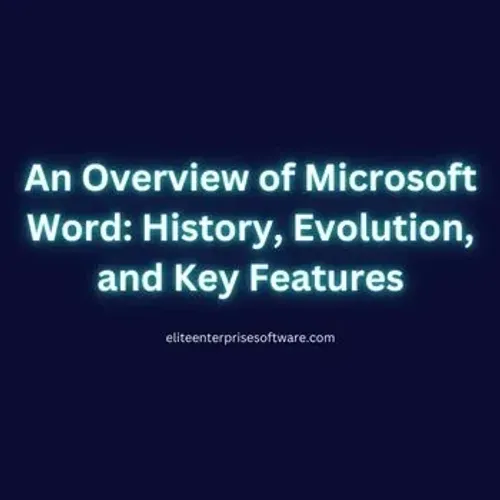An Overview of Microsoft Word: History, Evolution, and Key Features

WHAT IS MICROSOFT WORD?
Microsoft Word is a word processing application developed by Microsoft and is a key component of the Microsoft Office productivity suite. Initially launched in 1983 as Multi-Tool Word for Xenix systems, it has evolved significantly over the years to become the standard tool for creating, formatting, and editing text documents. Word provides an extensive range of features that empower users to produce high-quality documents, such as letters, reports, contracts, and more.
Among its primary features, Word allows users to create and format documents using various themes, review work with change tracking, and share files for collaboration with others, no matter their location. It also supports multiple file formats, including .doc and .docx, the latter adhering to the international Office Open XML standard.
Over time, Word has introduced numerous innovations, including a ribbon interface, real-time co-authoring support, automatic cloud saving, dark mode, immersive reading enhancements, and the ability to save images in SVG format. It is available for both Windows and macOS and is included in Office 365, Microsoft’s cloud-based product suite, which has helped Word stay competitive in the era of software as a service.
WHAT ARE THE VERSIONS OF MICROSOFT WORD?
Microsoft Word has undergone various updates over the years, incorporating new features and enhancements. Here’s a summary of the key features from some of the recent versions:
Word 2013: This version featured a redesigned interface with a greater focus on collaboration and document sharing. It enhanced editing and reviewing tools to facilitate teamwork.
Word 2016: This release further improved collaborative features, enabling users to work together in real-time. It also introduced the 'Tell Me' feature, which helps users quickly find Word functionalities.
Word 2019: While specific details are not provided, this version generally offered performance enhancements and added new ink features, data types, functions, and learning tools, along with improvements for dark mode.
Word for the Web: This browser-based version allows users to create, view, and edit documents directly in a web browser, facilitating online document sharing and collaboration.
Word in Office 2021: New features in this version include enhancements to Dark Mode, a 'Focus on Line' feature to help improve reading concentration, the addition of enhanced multimedia content to the Microsoft 365 Premium Creative Content Collection, and support for saving images and graphics in SVG format. Performance improvements were also made across Word, Excel, PowerPoint, and Outlook.
Earlier versions of Office, such as Office 2007, 2010, and 2013, introduced significant changes over the years, affecting fonts, text formatting, and providing enhanced tools for paragraph management.
WHAT CAN I DO WITH MICROSOFT WORD?
Microsoft Word is a versatile tool for creating a wide array of text documents with professionalism and ease. This powerful word processor allows you to start from scratch or select from a variety of predefined templates to create letters, reports, resumes, brochures, and more. You can format text in multiple ways, such as bold, italic, and using bulleted or numbered lists, while enriching your documents with images, shapes, and multimedia content.
Word excels in collaboration, enabling you to write and edit alongside others in real time. It offers advanced features such as voice dictation and search tools to help gather and cite sources. Whether you’re working on an academic project, preparing a business document, or jotting down ideas, Word is the ideal tool to turn your words into impactful visuals.
WHICH WORD IS RIGHT FOR YOU?
For users who prioritize collaboration and teamwork, Microsoft 365 is the best option. This subscription-based version includes Word and other Microsoft applications, such as Excel and PowerPoint, and provides advanced features for real-time collaboration, automatic cloud document storage, and access to 1 TB of storage space on OneDrive per user. This setup allows users to work together on shared documents from any location and device, facilitating cooperation and information sharing.
For creative writers, the choice may depend on personal preference and project requirements. While Microsoft Word offers a familiar and feature-rich environment for writing and formatting text, some writers may prefer specialized software like Scrivener, known for its versatility in structuring complex works. Nevertheless, Word remains a strong choice for those seeking a familiar interface and compatibility with other programs.
For corporate tasks, Microsoft 365 presents substantial advantages with its collaborative features, including technical support, and ongoing application updates. The capacity to activate numerous workstations, alongside access to communication and work management tools, makes Microsoft 365 a robust solution for business needs.
Finally, for academic writing, Word continues to be an essential tool with its advanced formatting, proofreading, and commenting capabilities, as well as integration with bibliographic reference managers. Students and researchers can benefit from either Microsoft 365 for the latest features or Office 2021 for those preferring a one-time purchase without a subscription requirement.

